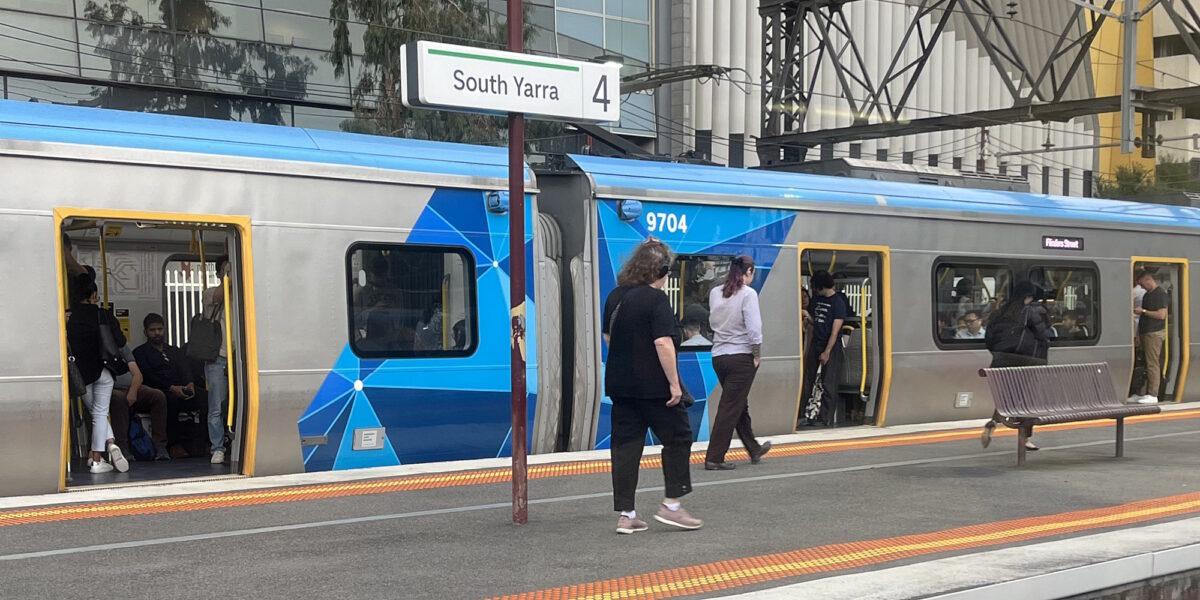The Vic government data for public transport monthly patronage by day type and mode got a refresh in mid-February, and now covers 2018 to the end of 2023.
So I thought I’d do a few charts from this data.
Let’s start with Melbourne’s trams.
If I’ve done these charts correctly, you should be about to mouse over parts of the chart to see more info. You’ll notice some gaps in the charts, which are due to there often being few regular (non-school holiday) weekdays in January.
We all know the basic story – patronage dropped in 2020 during the pandemic, and hasn’t come back on weekdays due to widespread work from home. But weekend patronage is almost back to what it was pre-pandemic, in some cases exceeding it.
More interestingly, tram Saturday patronage levels are very close to Mondays – which are the quietest weekday on much of the public transport network.
This might reflect that (with some exceptions) weekend tram frequencies are generally pretty decent, making services convenient for a wide range of trips, not just work commutes.
Over on V/Line the overall trend is pretty similar. Monday is again the quietest weekday.
Weekend patronage had mostly recovered by late 2021, and the numbers start to show the effects of the fare cut in mid-2023, tempered by other factors including major works.
Perhaps not obvious from the chart is that in late 2023, weekend patronage was often 25% or more above 2019 levels, and midweek (Tuesday/Wednesday/Thursday) in some months approaching 95% of 2019 levels.
Wednesday patronage dipped in December 2023 – probably the result of industrial action on Wednesday 13th December.
On the buses, Monday figures in 2022 and 2023 are similar to other weekdays, perhaps reflecting that more bus routes serve trips taken by people who have less opportunities to work from home.
Weekend bus patronage has been pretty strong, with Sundays exceeding pre-pandemic levels every month since October 2022. Given how strong overall weekend travel demand is, imagine how well buses could do if more routes had decent timetables.
Finally, here’s Metro patronage.
Possibly this is the mode that most clearly shows the changes in weekday travel. Prior to the pandemic, patronage was pretty similar across all weekdays. Coming out the other side, a different pattern has emerged: Mondays and Fridays are quieter, with the middle of the week being the busiest days.
This is a pattern repeated across many cities: a lot of white-collar workers are at home on Mondays and Friday, and in the office on Tuesday, Wednesday and Thursday (amusingly sometimes referred to as TWAT).
Metro patronage being higher on Friday than on Monday might be because of Friday night journeys for sporting or other events.
I also charted Metro 2020-23 patronage as a percentage of 2019.
What’s interesting here is that Saturday and Sunday travel on Metro is now sometimes higher than before the pandemic.
Apparently part of this is attributable to strong AFL attendances – a record 8.1 million in 2023, up from 7.5 million in 2019. But weekend patronage is strong outside footy season too.
To me it just underscores that more improvements to weekend services are needed, especially to fill the ridiculous 30-40 minute gaps on Sunday mornings on many Metro lines.
Melbourne’s big city status means lots of people are travelling every day of the week. The sooner the government realises that, and accepts that we need frequent public transport all day every day – including weekends – the better.
UPDATES: I initially made an error with some of the Metro data (thanks to John in the comments for noticing it), which resulted in recent weekend numbers appearing higher than they really are. This has been corrected and the text modified to reflect this.

7 replies on “Patronage update”
There appears to be some oddities in the Metro patronage data from 2020. Based on the figures above, weekend rail patronage was 70-80% of baseline in August & September 2020 during an extended stage 4 lockdown, whilst weekday rail patronage was less than 8%.
Other similar lockdown periods, e.g. September 2021, had low very utilisation of the rail network across the entire week.
@John – thank you – apologies, I messed up some of the weekend numbers for Metro and V/Line. Have corrected, and will check some others – hopefully no more errors.
These stats would definitely justify making various services including public transport available at about the same level of service (or at least close to it) on weekends as on weekdays. People enjoy the option of working on a flexible basis, including working from home, but they now also enjoy going out more on weekends.
Hey Daniel, nice job – you will have to update your Sydney vs Melbourne comparison as Sydney is now getting 25-27% of tram patronage compared to Melbourne!
Melbourne: 152,092,229 tram passengers in 2023
Sydney: 37,688,128 tram passengers in 2023
I wonder how these figures are determined considering the high level of fare evasion across the public transport network, particularly on metropolitan buses.
@Paul, here’s the fine print on the data:
Patronage data is derived from myki ticketing data. As ticketing data provides an incomplete picture of the number of people using public transport, DTP also conducts a patronage survey to supplement myki data. The purpose of the patronage survey is to determine the transaction rate, which is the percentage of passengers who ‘touch-on’ when they travel. Ticketing transactions are boosted according to the transaction rate to provide an estimate of total patronage.
[…] Like other modes, Mondays are quieter than the other weekdays. A regular pattern has emerged: many Melbourne CBD office workers travel in part of the week, with midweek journeys being the most popular. […]